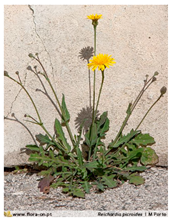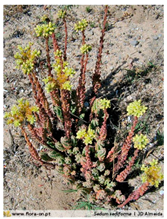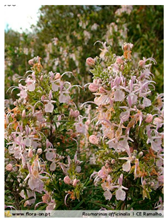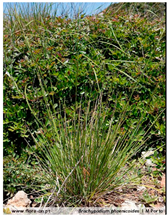Abstract
Green roof energy performance is still a challenging topic, namely in a Mediterranean climate since it depends on building characteristics, roof type, and also on climatic conditions. This paper evaluates green roof buildings’ energy needs and use in a Mediterranean climate. An experimentally calibrated numerical model was used to perform a parametric analysis and identify the influence of key parameters in heating and cooling energy needs, as well as annual energy use. The vegetation height, the soil depth, and LAI (leaf area index) were identified as the key parameters. The irrigation levels were also crucial for the energy performance of green roofs, particularly during the summer period and in a Mediterranean climate. Heating energy needs were mainly associated with soil depth due to higher thermal resistance, whereas cooling energy needs depended mostly on LAI, which influenced evapotranspiration and shading effects. A reduction of soil depth from 1.0 m to 0.1 m increased winter energy needs by up to 140%, while low values of LAI increased cooling energy needs up to 365%. Annual energy use in a Mediterranean climate showed a higher dependence on soil depth, with oscillations of up to 115%, followed by LAI and vegetation height. Finally, irrigation levels impacted the annual energy use more significantly for lower watering flow rates. Reductions of about 500% were obtained when changing watering flowrates from 0 mm/day to 6 mm/day in intensive green roofs. Since green roofs with native species expect low values of watering, this may increase their cooling energy needs.
1. Introduction
Green roofs are roofs covered with vegetation and a growing medium. Beneath the growing medium and above the structural support (mostly depending on building age), the constructive system may be composed of a waterproofing membrane, root barrier, drainage, and insulation [1].
The green roofs are classified into three types [2]: extensive, intensive, and semi-intensive. The extensive roof is characterized by a thin growing medium (6–25 cm), small plants, light, and requires minimal maintenance. On the other hand, the intensive roof is characterized as requiring more maintenance, supports a wider variety of plants, and is be heavier and thicker (15–70 cm) than the extensive roof. The semi-intensive roof has intermediate characteristics between the intensive and extensive roofs.
The purpose of this study is to demonstrate the benefits in energy performance of green roofs, although it also presents disadvantages [3]. A better energy performance is defined here as lower heating and cooling needs, as well as lower total energy use. The main disadvantages are the initial and maintenance costs, which are directly dependent on the green roof type [1,4,5]. Other disadvantage is the additional mass of the soil substrate, retained water, and vegetation that can be a concern to the structural resistance of the building. This makes it unlikely for intensive green roofs to be installed in older buildings [6]. In older ones, extensive green roofs could be an option due to its lighter weight. The green roofs have a significant variability of benefits including: (i) reducing the urban heat island effect by removing heat from the air through evapotranspiration, reducing temperatures of the surrounding air, and in a large scale, could absorb about 80% of the emitted heat by human activities [7,8]; (ii) reduce stormwater runoff and prevent floods by retaining rainwater in the substrate and then returning it to the atmosphere through transpiration and evaporation [9]; (iii) filter pollutants and heavy metals out of rainwater [10]; (iv) reduce air pollution and greenhouse gas emissions since vegetation has the capacity to filter the air [11]; (v) increase sound isolation since the soil helps to block lower frequencies and the plants block higher frequencies [12]; (vi) improve quality of life since green roofs can provide aesthetic value and habitat for many species that otherwise would have limited natural space in cities [5]; and (vii) reduce energy use since green roofs can absorb heat and act as a thermal insulator, reducing cooling and heating energy needs [1,13]. The present work focuses on the last referred benefit: the building energy performance of green roofs.
A literature review shows a growing debate regarding the relative building HVAC (heating, ventilation and air conditioning) energy savings of green roofs (e.g., References [1,3,7,14,15]). Several studies in the Mediterranean climate were reviewed that identified different energy performances of green roofs in heating and cooling seasons [6,16,17,18], showing a high variability in energy savings. One significant highlighted factor is the maintenance and irrigation costs that could compromise the benefit of using green roofs in these areas. Therefore, green roofs’ vegetation would benefit from using native species that require less maintenance and irrigation. The impact of different irrigation scenarios has been evaluated for urban heat reduction in Heusinger et al. [19], but not for building energy performance. The present paper overcomes this gap and investigates the impact of vegetation, substrate, and irrigation on the energy performance of green roofs in a Mediterranean climate, for both the heating and cooling seasons, with and without native species, through a parametric study on an experimentally validated green roof model.
2. Materials and Methods
A case study in Lisbon is chosen to experimentally assess the thermal behavior of a green roof and build a numerical model in EnergyPlus [20]. Following validation, the numerical model is used to perform a parametric analysis, varying the soil and plant characteristics, as well as irrigation flow rates. This methodology allows for estimating the energy performance of different types of green roofs and is clarified in Figure 1.
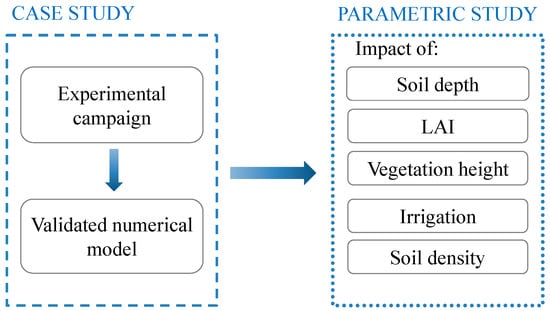
Figure 1.
Methodology flowchart. LAI—leaf area index.
2.1. Case Study: Experimental and Numerical Evaluation
A technical sound room with a total floor area of 17.2 m2 and a ceiling height of 2.2 m, located in the main building of the Calouste Gulbenkian Foundation, Lisbon (38°7′ N, 9°1′ W) Portugal, was selected for thermal monitoring (Figure 2a,b). As illustrated in Figure 3, the room also has a suspended ceiling with a maximum air gap of 1.30 m. The walls and floor of the compartment can be considered adiabatic, since it is surrounded by conference rooms and a corridor, acclimatized by a centralized air-conditioning system. The green roof (Figure 2b) has a 0.20-m concrete slab without thermal insulation, beams of 0.90 m, a 0.10-m drainage layer of gravel with a filter layer and a 0.25-m thick soil layer protected with grass (0.10 m). Irrigation of 6 mm/day occurs only during the summer period (June to September) when the soil humidity is lower than 40% of the saturation point.
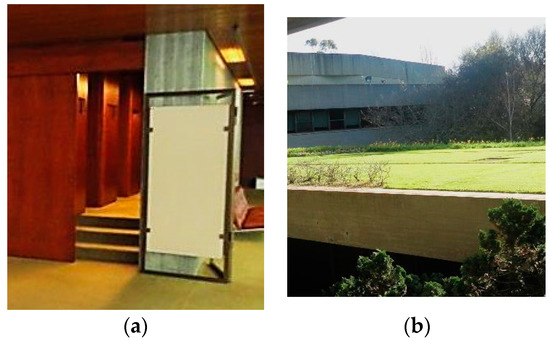
Figure 2.
Technical sound room in the Calouste Gulbenkian Foundation: (a) entrance area and (b) green roof.
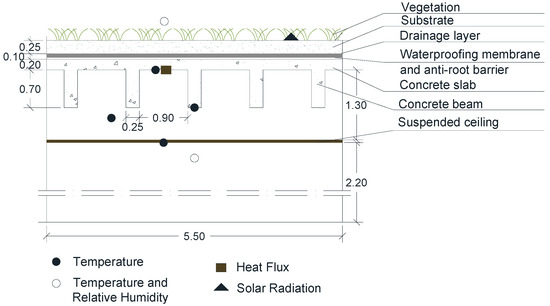
Figure 3.
Measurement setup of the technical sound room in the Calouste Gulbenkian Foundation.
Lisbon is classified as a Csa Mediterranean climate according to the Köppen-Geiger classification due to its hot and dry summers and mild to cool wet winters, high solar radiation, and uneven rainfall patterns [21,22,23]. As fall and spring do not present substantial energy needs and indoor thermal discomfort conditions, the thermal performance of the green roof was monitored separately during two representative periods: a heating season from 21–30 January and cooling season from 5–11 July 2013. The full experimental study is published in Silva et al. [6], and in Figure 3, the measurement setup is illustrated. These include: (i) outdoor and indoor temperatures and humidity, (ii) outdoor and indoor surface temperatures, (iii) heat fluxes, and (iv) global solar radiation in both vertical and horizontal planes. The measurement setup involved the following equipment: type-T thermocouples (Twin Twist 0.2 mm Copper/Constantan Thermocouple, thermocouple junctions welded with L60+ Thermocouple & Fine Wire Welder, Labfacility, West Sussex, UK) for temperature measurements, heatfluxmeters Hukseflux HFP01 (Hukseflux Thermal Sensors, Delft, The Netherlands) for heat fluxes, thermohygrometers TGP4500 Tinytag (Gemini Data Loggers Ltd., West Sussex, UK) and Rotronic HygroLog and HigroClip (Rotronic AG, Bassersdorf, Switzerland) for both ambient humidity and temperature, and pyranometers LI-COR LI-200SA (LI-COR, Lincoln, NE, USA) for solar radiation. Measurements were recorded as 10-minute averages from 1-minute readings using data loggers DeltaT DL2e (Delta-T Devices, Cambridge, United Kingdom) and DataTaker 50 (Thermo Fisher Scientific, Scoresby, Australia).
EnergyPlus (U.S. Department of Energy, Berkeley, CA, USA) [20] integrates a green roof model developed by Sailor [24] that was used to evaluate the thermal performance of the technical sound room. Heat fluxes) only occur through the green roof, since the walls and floor of the compartment can be considered adiabatic. The different layers of the green roof (Figure 3) have distinct properties including thermal conductivity: 2.3 W/m2 °C for the concrete (slab and beams), 2.0 W/m2 °C for the drainage layer of gravel with a filter layer, and 1.0 W/m2 °C for the soil layer. The EnergyPlus green roof model combines all inputs to approximate the global behavior of the roof. Due to experimental measurement complexity, some parameters were adopted according to References [20,24], such as: minimum stomatal resistance of 180 s/m, leaf emissivity/reflectivity of 0.95/0.25, and thermal/solar/visible absorptance of 0.9/0.8/0.8.
The numerical model was validated for the total period of the experimental campaign by comparing experimental and numerical results of indoor and surface temperature distributions. Also, in situ conditions were reproduced in the numerical model, namely: (i) internal gains of 7 W/m2 and air-conditioning system (setpoint temperature of 19 °C in the winter and 24 °C in the summer) between 9:00 h and 20:00 h; (ii) watering of 6 mm/day during the cooling season (June to September), every Monday, Wednesday, and Friday, for 30 minutes, two times a day, at 10:00 h and at 14:00 h; (iii) air flow of 3 m3/h∙m2; (iv) local weather conditions, such as outdoor temperatures and solar radiation, measured during the campaigns; and (v) green roof with vegetation height of 0.10 m, LAI of 2, and soil thickness of 0.25 m.
The mean bias error (MBE) and root-mean-square error (RMSE) obtained when comparing experimental and numerical indoor and surface temperature are shown in Figure 4. These results were used to assess the accuracy of the numerical model. MBE and RMSE ranged from 0.60 to 1.60 and from 1.2 to 1.8, respectively, which is in accordance with results from other authors [24,25]. Hence, the numerical model is considered to be representative of the green roof and was therefore used to evaluate the energy performance of different types of green roofs in the next section.
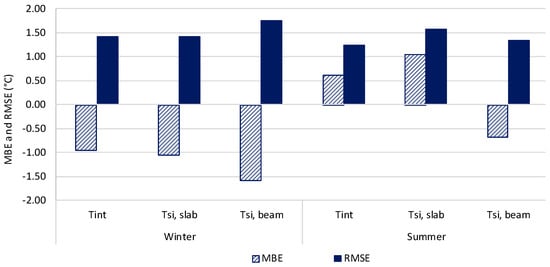
Figure 4.
Mean bias error (MBE) and root-mean-square error (RMSE) of the indoor temperature (Tint) and of the internal surface temperatures in the slab (Tsi,slab) and beam (Tsi,beam) for validation of the numerical model.
2.2. Parametric Study
A total of 26 tests were performed varying the following key parameters: soil depth (d), leaf area index (LAI), vegetation height (h), irrigation (i), and soil density (ρ). Figure 5 illustrates the combinations assessed in a flowchart. The synthetic weather file of Lisbon, Portugal, based on thirty years of meteorological data from INETI (Instituto Nacional de Engenharia, Tecnologia e Inovação) synthetic data for Portugal [26] was used to perform the annual energy simulations of the proposed scenarios. To be able to understand the influence of irrigation in this parametric study, in a first stage, the irrigation was always turned on throughout the year (both the heating and cooling season) and activated when the soil humidity was lower than 40% of the saturation point. In a second stage, irrigation was considered in a similar way but only during the cooling season in order to simulate common irrigation pattern for native species in a Mediterranean climate. It is important to note that not all analyses correspond to realistic scenarios of green roofs, such as the combination of a soil depth of 0.10 m and vegetation height of 1.0 m. However, all analyses are relevant to evaluate the impact of each parameter variation in the energy performance of the green roof.
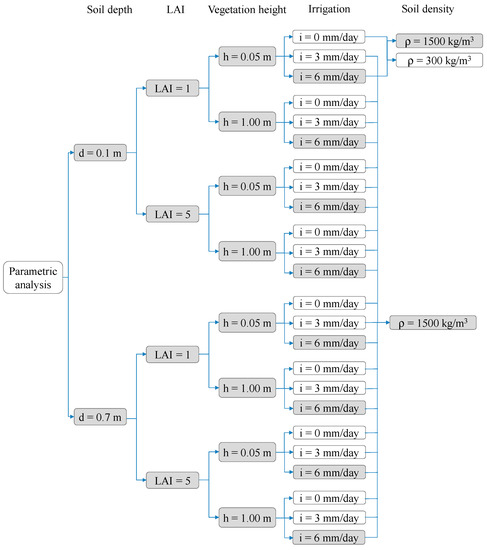
Figure 5.
Flowchart of the parametric analysis (highlighted in grey are the combinations used to assess the impact of vegetation and substrate).
Table 1 identifies four species presenting different levels of leaf area index (LAI) and vegetation height (h), covering some of the case studies analyzed in the present study, and is shown in Figure 5.

Table 1.
Vegetation height (h) and leaf area index (LAI) of different species.
3. Results and Discussion
The heating and cooling energy needs, as well as the annual energy needs for the combinations of LAI, irrigation, vegetation height, and soil depth listed in Figure 5 are shown in Table 2. Heating and cooling energy needs were computed for set point temperatures of 20 °C and 25 °C, respectively, during one entire year. In fact, heating and cooling energy needs in a Mediterranean climate, such as that of Portugal, correspond mostly to winter and summer demands since fall and spring do not present significant needs. Annual energy use was calculated from the energy needs for heating and cooling, assuming multi-split air conditioning systems of class B with a COP (coefficient of performance) of 3.40 and EER (energy efficiency ratio) of 3.00 for heating and cooling seasons, respectively [28].

Table 2.
Heating and cooling energy needs and the annual energy needs for all tests of the parametric analyses.
It can be observed from Table 2 that higher levels of irrigation introduced energy benefits during the cooling period. On the contrary, in the heating period, irrigation increased the energy needs. However, in terms of annual energy use, higher irrigation levels led to smaller energy consumptions. This was mainly noticed when comparing i = 0 mm/day and i = 3 mm/day. The differences between i = 3 mm/day and i = 6 mm/day were considerably lower.
When analyzing a green roof’s energy performance in a Mediterranean climate, it should be taken into account that precipitation assures the irrigation needs of the native species are satisfied during the winter season. Therefore, in the subsequent analysis (Section 3.1 and Section 3.2), irrigation is assumed only during the cooling season. The influence of vegetation and substrate characteristics, as well as irrigation levels, are presented in Section 3.1 and Section 3.2.
3.1. Impact of Vegetation and Substrate
Figure 6 shows the heating and cooling energy needs and annual use for eight different green roofs, with different combinations of LAIs, vegetation heights, and soil depths. These combinations are also highlighted in Figure 5 where it was assumed there was a soil density of 1500 kg/m3 and irrigation of 6 mm/day [29], only during the cooling season. The results of Figure 6 are per square meter, which is obtained by dividing the heating energy needs (for i = 0 mm/day) and cooling energy needs (for i = 6 mm/day) of Table 2 by the technical sound room floor area (17.2 m2).
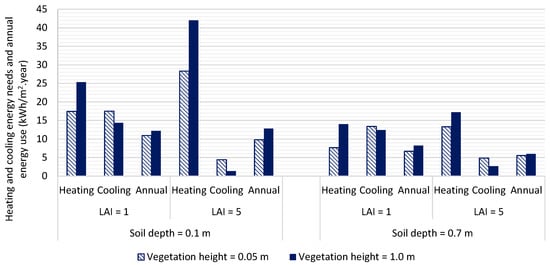
Figure 6.
Heating and cooling energy needs and annual use for different LAIs, vegetation heights, and soil depths per sqm.
It was concluded from Figure 6 that higher values of LAI decreased the cooling energy needs and increased the heating energy needs. This was as expected since green roofs with higher values of LAI have more shading and evapotranspiration, which results in lower solar heat gains and a cooling effect. Annual energy use of green roofs with higher values of LAI is lower in the Mediterranean climate. Similar results of the influence of LAI in thermal losses of green roofs were obtained in References [15,18,30].
As pointed out by several authors [31,32,33], energy needs also vary with vegetation height. Figure 6 shows that higher vegetation leads to higher energy needs in the heating season and lower energy needs in the cooling season. In fact, higher values of vegetation height might increase wind velocity within the canopy, decreasing the aerodynamic resistance and facilitating the evapotranspiration cooling effect.
Thermal insulation and thermal mass increased with the soil depth of the green roof. As a result, the annual energy use with soil depth d = 0.7 m was lower than with d = 0.1 m, particularly due to the decrease of heating energy needs. During the cooling season, the extra insulation of deeper soil does not allow the roof to take full advantage of evapotranspiration cooling effect, as References [34,35] documented in their studies.
A sensitivity analysis was carried out in order to assess the influence of each vegetation and substrate parameter on the magnitude of heating and cooling energy needs. Percentages were computed using a green roof with the following characteristics as a reference: LAI = 5, h = 1.0 m, d = 0.7 m, and i = 6 mm/day during summer months. Results are presented in Figure 7.
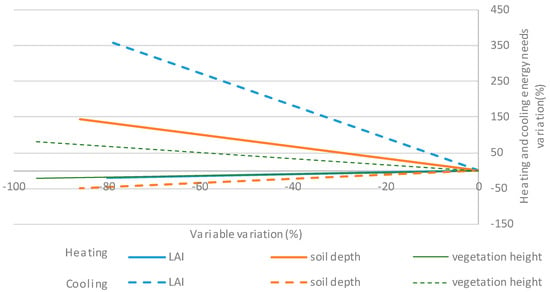
Figure 7.
Impact of vegetation and substrate variation on heating and cooling energy needs.
The results of Figure 7 confirm that LAI reductions significantly increased cooling energy needs while slightly changing heating energy needs, in accordance with the conclusions of References [18,31]. This was also noticeable for the variations in vegetation height. On the contrary, soil depth reduction increased the heating needs and had a lower impact on cooling energy needs. Additionally, Figure 8 shows that soil depth changes had a higher impact on annual energy use variations, followed by LAI and vegetation height. This was in accordance with the results of References [15,34].
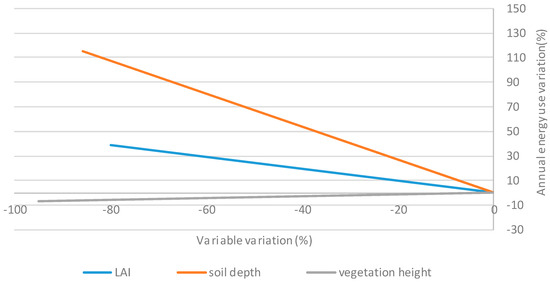
Figure 8.
Impact of vegetation and substrate variation on annual energy use.
Nowadays, extensive roofs are considered a solution for older buildings due to the thinner soil depth with reduced additional loads. It is also possible to use lighter substrates with a lower density. Therefore, the variation on heating and cooling energy needs when soil density decreased from 1500 to 300 kg/m3 was assessed. Figure 9 presents the variation in heating and cooling energy needs when soil density decreased from 1500 to 300 kg/m3 for the following extensive green roof characteristics: LAI = 0.1, vegetation height = 0.05 m, and soil depth = 0.1 m. The results show that decreasing the soil density from 1500 to 300 kg/m3 increased the annual energy use by 0.4% for irrigation of 6 mm/day and decreased it by 0.3% for 0 mm/day of irrigation. It is possible to conclude that this was not a significant variation. Changes in the density of thin green roofs soil showed no significant variations in the global thermal performance of the roof, neither in the heating nor cooling season. This may be associated with the combined effect of soil and vegetation on the energy performance of the roof. Since the soil depth was not significant, evapotranspiration and shading effects of vegetation might overcome the changes in soil properties. This conclusion might be different for thicker green roofs. However, the obtained results are useful to be able to conclude that extensive green roofs with lighter substrates can be an option for older buildings without losing the energy benefits of green roofs.
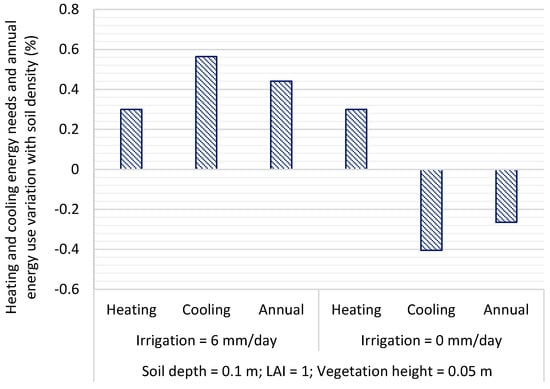
Figure 9.
Impact of soil density variation on heating and cooling energy needs and annual energy use for irrigation of 6 mm/day and 0 mm/day.
3.2. Impact of Irrigation
From the 26 tests shown in the flowchart of Figure 5, two green roof solutions were selected for the study of the irrigation impact: (i) an intensive green roof with higher and denser vegetation and a thicker substrate (LAI = 5; d = 0.7 m; h = 1 m); and (ii) an extensive green roof with low growing vegetation and a thinner substrate (LAI = 1; d = 0.1 m; h = 0.05 m). These descriptions of intensive and extensive green roofs are in accordance with [2].
Figure 10 presents the influence of irrigation on energy needs and use for intensive and extensive green roofs. As expected, for each green roof type, heating energy needs were constant. This happened because precipitation covered watering needs of the vegetation during winter months, and therefore no irrigation was scheduled during this period (i = 0 mm/day), as detailed in the beginning of Section 3. Moreover, it can be seen that extensive and intensive green roofs showed similar heating energy needs. This behavior can be explained due to the combined effect of thermal resistance and evapotranspiration of each green roof solution. Higher values of thermal resistance for intensive green roofs minimized heat lost when compared with extensive green roof solutions. However, the denser (higher LAI) and higher vegetation associated with intensive green roofs decreased the external surface temperature due to evapotranspiration and shading effects. The total heating energy needs in each case resulted from a balance of these two opposite effects, leading to similar values in extensive and intensive green roofs.
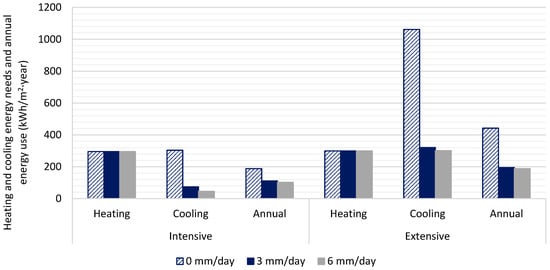
Figure 10.
Impact of irrigation variation on heating and cooling energy needs for annual energy use for intensive and extensive green roof solutions.
Figure 10 also illustrates that an increase in irrigation significantly reduced the cooling energy needs in intensive and extensive solutions, namely when watering flow rates increased from 0 mm/day to 3 mm/day. In this case, intensive and extensive green roofs with i = 3 mm/day required, respectively, 4.1 and 3.3 times less cooling energy needs than in the case of no irrigation during the summer. Higher irrigation flow rates (from 3 mm/day to 6 mm/day) further reduced the cooling energy needs, but this impact was not as significant (1.6 times less for intensive green roofs and almost negligible for extensive ones). Irrigation helped with reducing surface temperatures and was therefore more important in extensive solutions with lower evapotranspiration and shading effects since extensive green roofs have low growing vegetation, such as crawling vegetation and turfs. It was then concluded that the impact of irrigation was more important for irrigation flow rates from 0 to 3 mm/day rather than from 3 to 6 mm/day since the change in the outside surface temperature was more important in the first case.
4. Conclusions
This paper evaluated the energy performance of green roofs in a Mediterranean climate by performing a parametric analysis with 26 tests on an experimentally validated simulation model. The case study used to conduct this analysis is particularly pertinent because main heat fluxes occur through the green roof. Therefore, it allowed for identifying the key parameters of the green roof energy performance and quantifying their effect on energy needs and use. It is important to state that not all combinations of the parametric study corresponded to real species, but all are important to evaluate the impact of each parameter on the overall energy performance of the green roof. The influence of each parameter variation was assessed separately for heating and cooling periods.
During the heating season, soil depth and vegetation height were the most relevant parameters. A reduction of soil depth decreased the thermal resistance and consequently increased the winter energy needs by up to 140%. A reduction of vegetation height and LAI, in turn, decreased heating energy needs by up to 23% and 18%, respectively, namely due to higher evapotranspiration and shading effects. As precipitation was considered to be sufficient for the native species’ water needs during the heating season, irrigation was not considered.
In the cooling season, reductions of irrigation, LAI, and vegetation height led to higher cooling energy needs. Irrigation was the most important variable with reductions of about 500% when changing watering flows from 0 mm/day to 6 mm/day for intensive green roofs. However, its influence was particularly noticeable for initial watering. Since native species require less irrigation, which minimizes maintenance and watering costs, owners must be aware that this behavior can increase the cooling energy needs of the building.
Sparser vegetation, with low values of LAI, increased cooling energy needs by up to 365%, whereas smaller vegetation demanded 80% more energy. Soil depth showed a maximum energy variation of 50% for the summer period.
Concerning annual energy use, soil depth was the key factor, allowing oscillations of up to 115%. Thicker green roofs required less annual energy use for HVAC. Reductions in LAI produced higher values of energy use (up to 38%), while vegetation height had a smaller influence in the final performance, with a maximum influence of 7%.
These results can help designers seeking energy efficiency of green roofs in a Mediterranean climate to optimize green roof solutions. Complementary research may be performed for different case studies to further support the magnitude of values obtained in the present work.
Author Contributions
Conceptualization, M.G.G. and C.M.S.; methodology, M.G.G.; software, M.S.; validation, M.S.; investigation, M.G.G., C.M.S., A.S.V., and M.S.; writing—review and editing, M.G.G. and C.M.S. supervision, M.G.G. and C.M.S.
Funding
This research received no external funding.
Acknowledgments
The authors would like to acknowledge the Portuguese Calouste Gulbenkian Foundation co-operation in this research.
Conflicts of Interest
The authors declare no conflict of interest.
References
- Castleton, H.; Stovin, V.; Beck, S.; Davison, J. Green roofs; building energy savings and the potential for retrofit. Energy Build. 2010, 42, 1582–1591. [Google Scholar] [CrossRef]
- Forchungsgesellschaft Landschaftsentwicklung Landschaftsbau e.V. (FLL). Guidelines for the Planning, Construction and Maintenance of Green Roofing—Green Roofing Guideline; German Landscape Research, Development and Construction Society (FLL): Bonn, Germany, 2008. [Google Scholar]
- Berardi, U.; GhaffarianHoseini, A.; GhaffarianHoseini, A. State-of-the-art analysis of the environmental benefits of green roofs. Appl. Energy 2014, 115, 411–428. [Google Scholar] [CrossRef]
- Bianchini, F.; Hewage, K. How “green” are the green roofs? Lifecycle analysis of green roof materials. Build. Environ. 2012, 48, 57–65. [Google Scholar] [CrossRef]
- Sproul, J.; Wan, M.P.; Mandel, B.H.; Rosenfeld, A.H. Economic comparison of white, green, and black flat roofs in the United States. Energy Build. 2014, 71, 20–27. [Google Scholar] [CrossRef]
- Silva, C.M.; Gomes, M.G.; Silva, M. Green roofs energy performance in Mediterranean climate. Energy Build. 2016, 116, 318–325. [Google Scholar] [CrossRef]
- Santamouris, M. Cooling the cities—A review of reflective and green roof mitigation technologies to fight heat island and improve comfort in urban environments. Sol. Energy 2014, 103, 682–703. [Google Scholar] [CrossRef]
- Takebayashi, H.; Moriyama, M. Surface heat budget on green roof and high reflection roof for mitigation of urban heat island. Build. Environ. 2007, 42, 2971–2979. [Google Scholar] [CrossRef]
- Mentens, J.; Raes, D.; Hermy, M. Green roofs as a tool for solving the rainwater runoff problem in the urbanized 21st century? Landsc. Urban Plan. 2006, 77, 217–226. [Google Scholar] [CrossRef]
- Steusloff, S. Input and Output of Airborne Aggressive Substances on Green Roofs in Karlsruhe. In Urban Ecology; Breuste, J., Feldmann, H., Uhlmann, O., Eds.; Springer: Berlin/Heidelberg, Germany, 1998. [Google Scholar]
- Yang, J.; Yu, Q.; Gong, P. Quantifying air pollution removal by green roofs in Chicago. Atmos. Environ. 2008, 42, 7266–7273. [Google Scholar] [CrossRef]
- Connelly, M.; Hodgson, M. Experimental investigation of the sound transmission of vegetated roofs. Appl. Acoust. 2013, 74, 1136–1143. [Google Scholar] [CrossRef]
- Jaffal, I.; Ouldboukhitine, S.-E.; Belarbi, R. A comprehensive study of the impact of green roofs on building energy performance. Renew. Energy 2012, 43, 157–164. [Google Scholar] [CrossRef]
- Ascione, F.; Bianco, N.; Rossi, F.D.; Turni, G.; Vanoli, G.P. Green roofs in European climates. Are effective solutions for the energy savings in air-conditioning? Appl. Energy 2013, 104, 845–859. [Google Scholar] [CrossRef]
- Sailor, D.J.; Elley, T.B.; Gibson, M. Exploring the building energy impacts of green roof design decisions - a modeling study of buildings in four distinct climates. J. Build. Phys. 2012, 35, 372–391. [Google Scholar] [CrossRef]
- Niachou, A.; Papakonstantinou, K.; Santamouris, M.; Tsangrassoulis, A.; Mihalakakou, G. Analysis of the green roof thermal properties and investigation of its energy performance. Energy Build. 2001, 33, 719–729. [Google Scholar] [CrossRef]
- Olivieri, F.; Di Perna, C.; D’Orazio, M.; Olivieri, L.; Neila, J. Experimental measurements and numerical model for the summer performance assessment of extensive green roofs in a mediterranean coastal climate. Energy Build. 2013, 63, 1–14. [Google Scholar] [CrossRef]
- Theodosiou, T.G. Summer period analysis of the performance of a planted roof as a passive cooling technique. Energy Build. 2003, 35, 909–917. [Google Scholar] [CrossRef]
- Heusinger, J.; Sailor, D.J.; Weber, S. Modeling the reduction of urban excess heat by green roofs with respect to different irrigation scenarios. Build. Environ. 2018, 131, 174–183. [Google Scholar] [CrossRef]
- EnergyPlus. Energy Simulation Software. 2013. Available online: http://apps1.eere.energy.gov/buildings/energyplus (accessed on 23 September 2013).
- Peel, M.C.; Finlayson, B.L.; McMahon, T.A. Updated world map of the Köppen-Geiger climate classification. Hydrol. Earth Syst. Sci. 2007, 11, 1633–1644. [Google Scholar] [CrossRef]
- Rubel, F.; Kottek, M. Observed and projected climate shifts 1901–2100 depicted by world maps of the Köppen-Geiger climate classification. Meteorol. Z. 2010, 19, 135–141. [Google Scholar] [CrossRef]
- Moret Rodrigues, A.; Santos, M.; Gomes, M.; Glória Duarte, R. Impact of natural ventilation on the thermal and energy performance of buildings in a Mediterranean climate. Buildings 2019, 9, 123. [Google Scholar] [CrossRef]
- Sailor, D. A green roof model for building energy simulation programs. Energy Build. 2008, 40, 1466–1478. [Google Scholar] [CrossRef]
- Ouldboukhitine, S.-E.; Belarbi, R.; Sailor, D.J. Experimental and numerical investigation of urban street canyons to evaluate the impact of green roof inside and outside buildings. Appl. Energy 2014, 114, 273–282. [Google Scholar] [CrossRef]
- UIUC; LBNL. EnergyPlus Documentation. U.S. Department of Energy, 2010. Available online: https://energyplus.net/documentation (accessed on 10 June 2019).
- Flora-On: Flora de Portugal Interactiva. Sociedade Portuguesa de Botânica. (License Creative Commons Attribution-NonCommercial 4.0 International—CC BY-NC 4.0). 2014. Available online: https://flora-on.pt/images/Acordo_Utilizacao_Dados_Geograficos_Flora-On.pdf (accessed on 10 June 2019).
- REH. Regulation of the Energy Performance of Residential Buildings; Decree-law 118/2013 of 20 of August 2013; Ministry of Economy, Innovation and Development (in Portuguese): Diário da República, Portugal, 2013; pp. 4988–5005. Available online: https://dre.pt/application/conteudo/499237 (accessed on 12 March 2018).
- Cudell, G. Manual for Installation of Irrigation Systems. 2000. Available online: http://cudell.pt/sites/cudell.pt/files/files/OS/Manual_Instalador/Manual_de_Instalacao_de_Rega.pdf (accessed on 10 April 2019).
- Fang, C.-F. Evaluating the thermal reduction effect of plant layers on rooftops. Energy Build. 2008, 40, 1048–1052. [Google Scholar] [CrossRef]
- Liu, K.; Minor, J. Performance Evaluation of an Extensive Green Roof. In Proceedings of the Third Annual Greening Rooftops for Sustainable Communities Conference, Awards and Trade Show, Washington, DC, USA, 4–6 May 2005. [Google Scholar]
- Niu, H.; Clark, C.; Zhou, J.; Adriaens, P. Scaling of Economic Benefits from Green Roof Implementation in Washington, DC. Environ. Sci. Technol. 2010, 44, 4302–4308. [Google Scholar] [CrossRef] [PubMed]
- Ouldboukhitine, S.-E.; Belarbi, R.; Jaffal, I.; Trabelsi, A. Assessment of green roof thermal behavior: A coupled heat and mass transfer model. Build. Environ. 2011, 46, 2624–2631. [Google Scholar] [CrossRef]
- Wong, N.; Cheong, D.; Yan, H.; Soh, J.; Ong, C.; Sia, A. The effects of rooftop garden on energy consumption of a commercial building in Singapore. Energy Build. 2003, 35, 353–364. [Google Scholar] [CrossRef]
- Nardini, A.; Andri, S.; Crasso, M. Influence of substrate depth and vegetation type on temperature and water runoff mitigation by extensive green roofs: Shrubs versus herbaceous plants. Urban Ecosyst. 2012, 15, 697–708. [Google Scholar] [CrossRef]
© 2019 by the authors. Licensee MDPI, Basel, Switzerland. This article is an open access article distributed under the terms and conditions of the Creative Commons Attribution (CC BY) license (http://creativecommons.org/licenses/by/4.0/).
